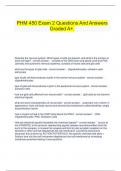Tentamen (uitwerkingen)
PHM 450 Exam 2 Questions And Answers Graded A+.
PHM 450 Exam 2 Questions And Answers Graded A+.
Describe .the .nervous .system. .What .types .of .cells .are .present, .and .what .is .the .function .of .each .cell .type? .- .correct .answer. . . . .consists .of .the .CNS .(brain .and .spinal .cord) .and .PNS .(somatic .and .aut...
[Meer zien]
Voorbeeld 3 van de 24 pagina's
Geupload op
23 augustus 2024
Aantal pagina's
24
Geschreven in
2024/2025
Type
Tentamen (uitwerkingen)
Bevat
Vragen en antwoorden
phm 450 exam 2 questions and answers graded a
describe the nervous system what types of cells a
type of glia cell that produces myelin in the cent
Instelling
PHM 450
Vak
PHM 450
€12,13
100% tevredenheidsgarantie
Direct beschikbaar na betaling
Zowel online als in PDF
Je zit nergens aan vast
PHM 450 Exam 2 Questions And Answers





